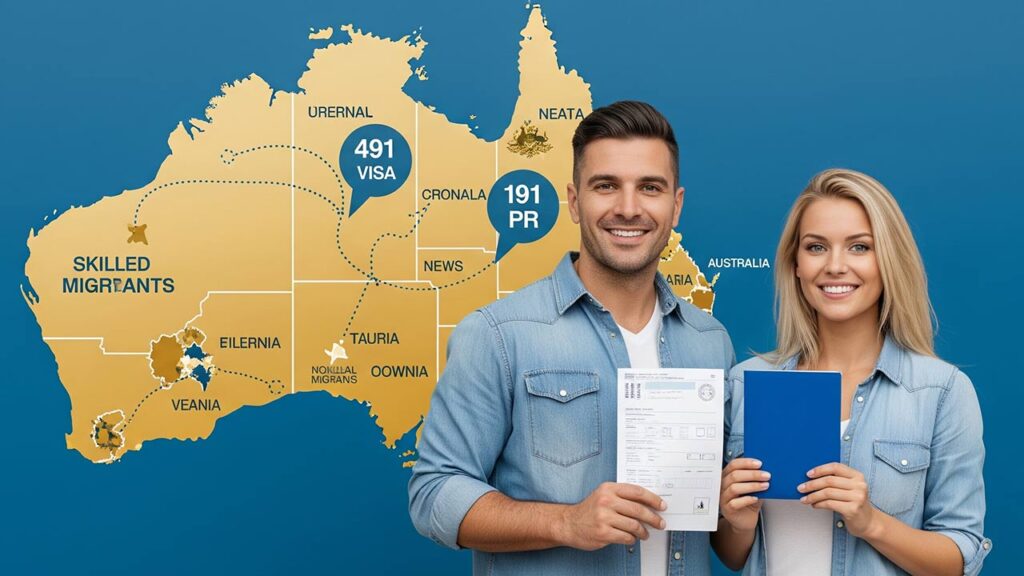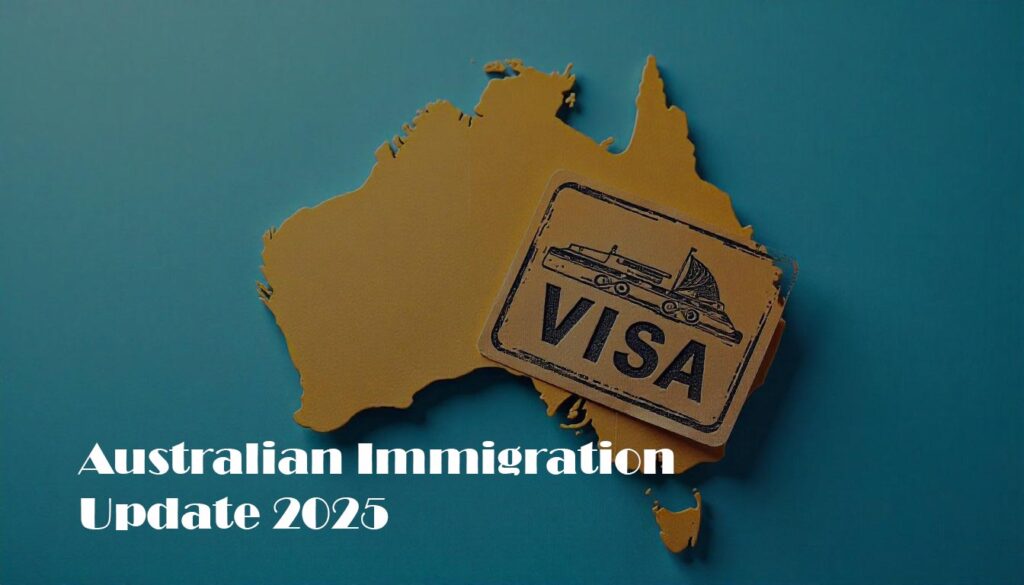When international students come to study in Australia, they are not only focused on acquiring a quality education but also on making long-term plans, which include becoming permanent residents of the country. It is also important to know the pathways available to international students once their studies have been completed to make a successful transition.
Australia, known to be a friendly country in terms of immigration and facilitation of various opportunities, welcomes talented people to serve its economy and even its society. There are many after-study migration options available to students. This article elaborates on the major pathways of Australia PR to international students regarding the year 2025/26 as a roadmap to permanent residency.
Why International Students Are Important to Australia’s Migration Strategy
Foreign students become an important part of the general migration policy in Australia. The Australian government also lives with the giant importance of the people who are internationally educated and culturally adapted in the country. The government is encouraging them to stay by giving them a PR pathway to Australia, opportunities to stay in Australia and contribute to the economy since they have already invested in Australia by getting their education there and have indicated allegiance to the nation to reside and work in it.
International students are of high importance to Australia because of the good quality qualifications, in most cases, a good command of the English language, as well as successful adjustment to the country, making them a good prospect to address skill shortages and to grow the economy of country. This undertaking underlines an apparent course to PR for international students.
Graduate Visa (Subclass 485): Your First Step Towards PR
The Temporary Graduate Visa (Subclass 485) is often the foundational step for international students seeking pr pathway for international students in Australia. This visa allows recent graduates to stay and work in Australia temporarily, gaining valuable Australian work experience, which is often a critical requirement for skilled permanent residency visas.
The Subclass 485 visa has two main streams:
- Graduate Work Stream: For students who have completed a degree, diploma, or trade qualification related to an occupation on the Medium and Long-term Strategic Skills List (MLTSSL). The duration of this stream can be up to 18 months, or longer for eligible Hong Kong and British National (Overseas) passport holders.
- Post-Study Work Stream: Available to students who have completed a Bachelor’s degree or higher from a CRICOS-registered institution in Australia. The duration of this stream varies depending on the qualification, typically ranging from two to five years.
This visa serves as a crucial bridging visa, allowing graduates to enhance their employability, improve their English language proficiency, and gain the necessary work experience to become eligible for more permanent skilled visas, truly making it a graduate visa pr pathway.
Top PR Pathways for International Students in 2025/26
After securing your Temporary Graduate Visa, several pr pathways in Australia become accessible, depending on your qualifications, work experience, and personal circumstances. Here are some of the most common and effective routes for international students in 2025/26:
Skilled Independent Visa (Subclass 189)
Skilled Independent Visa (Subclass 189) is a point-tested permanent visa that is very popular and is intended to enable skilled workers who do not need to be sponsored by an employer, a state or a territory to live in Australia. Your occupation that has been nominated should be included in the Medium and Long-term Strategic Skills List (MLTSSL) to be considered eligible for the skilled visa in Australia.
To belong to the program, applicants need to file an Expression of Interest (EOI) and obtain a points threshold out on factors such as age, knowledge of the English language, skilled employment, and education qualifications. The candidates with top rankings in the SkillSelect system periodically receive an invitation to apply for this visa. This visa offers a direct pr pathway to Australia for individuals with in-demand skills.
State Nominated Skilled Visa (Subclass 190)
Another excellent PR pathway to international students is the State Nominated Skilled Visa (Subclass 190). The visa is a permanent one in which the state or territory governments in Australia nominate it. The occupation lists and nomination criteria differ depending on the state/territory involved, where local labour demands may have been incorporated into its planning.
International graduates who have graduated in one state may benefit from in-state nomination in this state and especially when their occupation appears in the skilled occupation list of the state. The applicants should also show that they have the sincere desire to live in the nominating state or territory until a stipulated time when the visa is issued.
Regional Skilled Visa (Subclass 491)
The Skilled Work Regional (Provisional) Visa (Subclass 491) is a provisional visa designed to encourage skilled migrants to live and work in designated regional areas of Australia. While not a direct permanent residency visa, it offers a strong regional pr Australia pathway to pr for international students. This 5-year provisional visa requires nomination by a state or territory government or sponsorship by an eligible family member residing in a designated regional area.
After holding the Subclass 491 visa for three years and meeting certain income and residency requirements, holders can apply for the Permanent Residence (Skilled Regional) visa (Subclass 191). Studying and working in designated regional areas can significantly increase your nomination chances due to higher demand for skilled workers and additional points in the points test.
Employer-Sponsored Visas (Subclass 482 and 186)
Employer-sponsored visas offer another viable employer-sponsored pr pathway. The Temporary Skill Shortage (TSS) visa (Subclass 482) allows employers to sponsor overseas workers to fill skill shortages. While the 482 visa is temporary, it can lead to permanent residency through the Employer Nomination Scheme (ENS) visa (Subclass 186). The Subclass 186 visa has three streams: the Temporary Residence Transition stream (for 482 visa holders who have worked for their employer for a certain period), the Direct Entry stream (for highly skilled applicants who meet specific criteria), and the Labour Agreement stream. Employer nomination criteria typically include demonstrating a genuine need for the position and offering market salary rates. Relevant occupations must be listed on the appropriate skilled occupation lists.
Global Talent Visa (Subclass 858)
The Global Talent visa (Subclass 858) offers an expedited pathway to direct permanent residency for highly talented individuals with exceptional achievements in specific target sectors. This includes highly skilled graduates and researchers in fields such as MedTech, FinTech, Agri-food, Space and Advanced Manufacturing, Energy and Mining Technology, and Quantum Information, Advanced Digital, Data Science and ICT. Suppose you have an internationally recognised record of exceptional achievement. In that case, this global talent visa can provide a fast-tracked pr pathway for international students who are truly at the top of their field.
Best Study Courses that Lead to PR in Australia
Choosing the right course is a critical decision that can significantly influence your PR pathway in Australia. Aligning your study field with occupations in high demand in Australia’s labour market can increase your chances of obtaining PR. These occupations are typically found on the Medium and Long-term Strategic Skills List (MLTSSL) and the Short-term Skilled Occupation List (STSOL).
Here are some of the best courses for pr in Australia that often lead to positive skill assessments and PR opportunities:
- Nursing: Australia has a consistent demand for registered nurses across various specialisations. Graduates from nursing programs often find themselves with excellent employment prospects and clear PR pathways through skilled migration visas.
- Information Technology (IT): With the rapid growth of the digital economy, IT professionals are highly sought after. Fields like software development, cybersecurity, data science, and business analysis consistently appear on occupation lists.
- Teaching: Qualified teachers, especially in early childhood, primary, and secondary education, are in demand, particularly in regional areas.
- Engineering: Various engineering disciplines, including Civil, Mechanical, Electrical, and Software Engineering, are consistently listed due to infrastructure development and technological advancements.
- Trade Qualifications: Trades such as carpentry, plumbing, electrical, and automotive mechanics are in high demand across Australia, offering strong pathways through vocational education and training (VET) programs.
- Accounting: Qualified accountants remain a perennial demand, with various specialisations consistently featuring on occupation lists.
- Social Work: Social workers play a crucial role in community support, and there is a consistent need for them across the country.
- Medical Sciences: Beyond nursing, other medical professionals like general practitioners, specialists, and allied health professionals (e.g., physiotherapists, occupational therapists) are in high demand.
Completing a course in one of these fields significantly increases your chances of being eligible for skilled migration and helps you get PR after studying in Australia.
Importance of Skill Assessments and Points Test
To be eligible for most skilled migration visas, you will need a positive skill assessment in Australia from the relevant assessing authority for your nominated occupation. Bodies like AHPRA (for health professionals), Engineers Australia, CPA Australia (for accountants), and the Australian Computer Society (ACS) for IT professionals, evaluate your qualifications and work experience against Australian standards. This assessment is a mandatory step.
Furthermore, the Australian skilled migration program operates on a points-tested system. Your Expression of Interest (EOI) score is crucial for receiving an invitation to apply for visas like the Subclass 189 and 190. You earn points for various factors, including:
- Age: Points are awarded for being within certain age brackets.
- English Language Proficiency: Higher scores in approved English tests (e.g., IELTS, PTE Academic) earn more points.
- Skilled Employment: Both Australian and overseas work experience in your nominated occupation contributes points.
- Qualifications: Australian qualifications receive additional points, especially higher degrees.
- Australian Study Requirement: Completing a minimum of two academic years of study in Australia.
- Regional Study: Studying in a designated regional area of Australia.
- Professional Year Programs: Completing a Professional Year Program (PYP) in an eligible occupation can provide additional points and valuable work experience.
- NAATI Accreditation: Gaining accreditation from NAATI (National Accreditation Authority for Translators and Interpreters) for community language skills.
- Partner Skills: If your partner also meets certain skilled migration criteria.
Maximising your points through these avenues is vital for increasing your chances of getting pr in Australia after studying.
How to Boost Your PR Chances After Graduation
Strategic planning and proactive steps can significantly enhance your eligibility to get pr after studying in Australia and streamline your pr pathway for international students.
- Gain Relevant Work Experience: While on your Temporary Graduate Visa (Subclass 485), focus on securing employment in your nominated occupation. Even unpaid internships or volunteer work in your field can be valuable.
- Improve English Test Scores: Aim for the highest possible scores in English language tests. Even a slight improvement can significantly boost your points.
- Apply for Regional Jobs: Consider moving to and working in designated regional areas. This can open up more state nomination opportunities (Subclass 190 or 491) and provide additional points.
- Complete Professional Year Programs: If your occupation is eligible (e.g., IT, Engineering, Accounting), undertaking a Professional Year Program (PYP) can provide valuable work experience, professional development, and additional points.
- Stay Updated with State Occupation Lists: State and territory skilled occupation lists can change frequently. Regularly check these lists to ensure your occupation remains in demand and to explore new opportunities.
- Network Extensively: Build connections within your industry. Networking can lead to job opportunities, mentoring, and valuable insights into the local job market.
- Consider a Higher Qualification: Pursuing a Master’s or PhD in Australia can not only deepen your expertise but also provide additional points for your qualifications.
Mistakes to Avoid When Planning Your PR Pathway
Navigating the Australian immigration system can be complex, and common pitfalls can derail your PR aspirations. Being aware of these mistakes is key to successfully getting pr in Australia after studying.
- Ignoring Regional Opportunities: Many students overlook the significant advantages of studying and working in regional Australia, which often has lower competition for nominations and additional points.
- Late Skills Assessments: Delaying your skills assessment can eat into your valuable Temporary Graduate Visa time, potentially leaving you with less time to gain relevant work experience or apply for PR.
- Poor Visa Planning: Not having a clear understanding of the visa pathways and their requirements from the outset can lead to missed opportunities or ineligible applications.
- Not Meeting State Nomination Criteria: Each state has unique requirements. Failing to research and meet these specific criteria for Subclass 190 or 491 can lead to rejection.
- Underestimating English Language Requirements: Many students assume their English is sufficient, but higher scores often provide crucial points for competitive PR applications.
- Inaccurate or Incomplete Documentation: Small errors or missing documents can cause significant delays or even outright refusal of your application.
- Failing to Track Policy Changes: Australian immigration policies can change. Not staying updated on new regulations, occupation lists, or points test criteria can impact your eligibility.
- Not Seeking Professional Advice: Attempting to navigate the complex immigration system without expert guidance can lead to costly mistakes and missed opportunities.
Avoiding these common errors will significantly improve your chances as an international student in PR Australia.
Final Thoughts
The journey to permanent residency in Australia after graduation is a rewarding one, but it requires diligent planning and execution. Early planning is crucial for securing PR after graduation. By strategically aligning your study choices, gaining relevant work experience, and carefully navigating the visa options, you can significantly enhance your prospects.
Encourage students to align their study, work, and location choices with PR strategy. Remember, the key is to stay informed, be proactive, and make choices that strengthen your eligibility for the desired pr pathways in Australia and ultimately achieve your goal of becoming a permanent resident. A well-thought-out pathway to pr for international students is your best bet for success.
How VXL Education Can Help You Get PR After Graduation
At VXL Migration and Education Consultants, we specialise in providing comprehensive and personalised migration services to international students aspiring for permanent residency in Australia. Our registered migration agents are equipped to offer expert guidance through every stage of your PR journey.
Our services include:
- Personalised PR Planning: We work with you to develop a tailored PR strategy based on your qualifications, experience, and aspirations, identifying the most suitable visa pathways.
- Assistance with Skills Assessments and EOIs: We guide you through the complex skill assessment process for your nominated occupation and assist with lodging a compelling Expression of Interest (EOI) through SkillSelect.
- Regional Migration Advice: We provide insights into the benefits and requirements of regional migration, helping you identify opportunities in designated regional areas.
- Employer Sponsorship and Graduate Visa Help: We assist with applications for the Temporary Graduate (Subclass 485) visa and advise on employer-sponsored pathways (Subclass 482 and 186), connecting you with potential employers where possible.
- Document Preparation and Review: We meticulously review all your documentation to ensure accuracy and completeness, minimising potential delays or refusals.
- Ongoing Support: From course selection to visa grant, our team offers continuous support and updates on policy changes.
Take the next step towards your Australian dream. Contact VXL Education today for expert guidance on your PR pathway after graduation!
FAQs
Q: How can I get PR in Australia after studying?
- You can get PR in Australia after studying primarily through skilled migration visas (Subclass 189, 190, 491) after completing your studies and gaining a Temporary Graduate visa (Subclass 485). Employer-sponsored visas (Subclass 186) and the Global Talent visa (Subclass 858) are also options.
Q: Which course gives PR easily in Australia?
- Courses that align with occupations on Australia’s skilled occupation lists, such as Nursing, IT, Engineering, Teaching, and Trade qualifications, tend to offer easier pathways to PR due to high demand for these skills.
Q: Is studying in regional Australia better for PR?
- Yes, studying in regional Australia often provides significant advantages for PR, including additional points in the points test and increased opportunities for state nomination (Subclass 190 and 491 visas) due to lower competition and specific regional needs.
Q: Which visa is best for PR after study?
- The “best” visa depends on your circumstances. The Temporary Graduate Visa (Subclass 485) is the crucial first step. Following that, skilled visas like Subclass 189 (Skilled Independent), Subclass 190 (State Nominated), or Subclass 491 (Regional Provisional) are common pathways, with the Subclass 186 (Employer Nomination Scheme) also being a strong option if you secure employer sponsorship.
Q: Can I include my partner in my PR application?
- Yes, in most skilled migration and employer-sponsored PR applications, you can include your de facto partner or spouse and dependent children in your application. They must also meet health and character requirements.
Q: What are the chances of getting PR as an international student?
- The chances of getting PR vary widely depending on factors such as your chosen occupation, English language proficiency, work experience, points score, and whether you are nominated by a state/territory or sponsored by an employer. Strategic planning and seeking expert advice can significantly improve your chances.
Q: How long does PR take after graduation?
- The total time to obtain PR after graduation can vary. It typically involves first securing a Temporary Graduate visa (2-5 years). After gaining relevant experience and meeting eligibility criteria, the processing time for skilled PR visas can range from a few months to over a year, depending on the visa subclass, the completeness of your application, and current processing queues.






